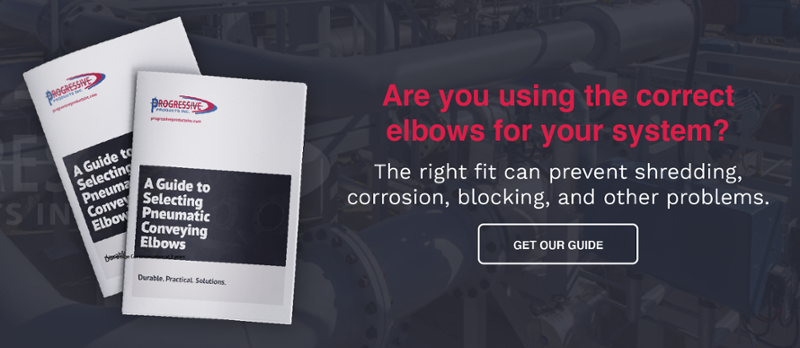Components of modern pneumatic conveying systems aren’t as radically different from their predecessors as you may expect, but, of course, a few improvements have been made. Pneumatic conveying systems are relatively old inventions that can be traced back to 1799 and the inventor William Murdoch. These types of systems were mainly used in London during the 1800s to transport mail around the city. Today, their main use is in industrial settings.
What Is A Pneumatic Conveying System?
Unlike other types of conveying systems, like belt, roller or slurry conveyors, a pneumatic conveying system doesn’t use direct contact or rely on mechanical means of transporting materials. Instead, it uses high-speed, pressurized air within pneumatic conveying components, such as pipes and tubes, to transport bulk materials, like cereal grains or sand.
The speed at which bulk materials are transported depends on several factors:
- The type of bulk material being conveyed
- The ratio between gas and solids
- Pressure
- The dimensions of the tubes
Pneumatic conveying components like pipes, elbows, and fittings obviously don’t move, nor do they have mechanical contact with the bulk material. Instead, air is pumped into the system and carries the material through a long series of tubes. In some cases, moving components, such as lump breakers, play a small role in conveying materials from one place to another, even though they are stationary in location.
What Does A Pneumatic Conveying System Do?
Pneumatic conveying systems are mainly used in industrial applications for conveying bulk materials. Some examples of the industrial activities they’re commonly used in are:
- Processing cereal grains
- Manufacturing molded plastics
- Processing sugar granules
- Feeding burners with alternative fuel, like rice grain husk
- Recycling materials
Any powdery, granulated, or small-sized bulk material is easier to transport within an industrial facility when a pneumatic conveying system is used.
What Are The Main Components Of A Pneumatic Conveying System And What Do They Do?
Pneumatic conveying components include various piping components, valves, fittings, and subsystems. The main components are:
- Motorized pumps and fans (compressors): These generate the flow and pressure of air in the system
- Feed system: This is crucial in inserting the bulk material in the gaseous stream without contaminating the storage or silos. Examples of this include rotary valves and Venturi-type ejectors
- Pipes and fittings: These serve as the conveyor line through which the bulk materials are conveyed. Examples of these components include flange couplings, elbows, and flow dividers
- Material-gas separator: This is a sub-system that separates the solid particles from the air when conveying materials and filling the silos. Some examples include centrifugal separators and reverse jet bag filters
- Lump breakers: As the name suggests, these components break lumps of materials, thereby facilitating the continuous flow of materials through the system
- Silos or storage: These components technically don’t participate in the actual conveyance of materials, but they are used to store the materials both at the start and end points
What Are The Common Design Flaws In Pneumatic Systems And How Do You Solve Them?
Although there aren’t a lot of moving parts in a pneumatic conveying system, there are still design flaws that can cause problems. These are mainly to do with the compatibility of components, like how the pneumatic conveying diverter valve performs with or impacts other components. Flaws in a system could also be caused by air pressure and the type of material being conveyed.
If you can’t solve these problems through internal maintenance, it’s best to get an expert opinion, and you may need to either repair or replace components in your system.
Here are some typical flaws in pneumatic conveying systems to watch out for:
- If your pressure/vacuum gauge is “bouncing” or reading higher or lower than normal, your system may be experiencing wear, line build-up, or reduced feed into the system.
- If you have product build-up or start seeing wear or holes in your elbows, you probably want to check your convey lines. Bear in mind that horizontal conveying is harder than vertical, and it’s important never to convey at 45 degree angle (or higher).
- Look out for internal leaks in your diverter valves, as they can fill your closed leg and create blockages.
- Holes and leaks in filter receivers or bin vents can be very detrimental to system performance. Check your timer board in the first instance to troubleshoot any problems, as it’s the best indicator of what’s going on inside the filter.
- Rotary valves are precision instruments put into a rough environment, so they tend to wear. They’re also the hardest part of a pneumatic conveying system to diagnose, but look out for a pressure drop, increased frequency of line plugging, and a “bouncing” blower pressure for signs that your rotary valve may need to be replaced.
What Are The Pros And Cons Of Pneumatic Conveying?
PROS OF PNEUMATIC CONVEYING
Using high-speed, pressurized air that flows inside tubes is an ideal means of transporting powdery and granular bulk materials because of the following reasons:
- Very low wastage: The probability of losing materials is low, since they are contained within sealed tubes.
- Fast conveyance: The speed of the materials depends on the speed of the air being pumped through the system. Therefore, bulk materials have the capacity of traveling very fast.
- Low friction: Since the materials have very limited contact with the machine, less friction is generated. This has positive knock-on effects for the lifespan of your conveying system.
- Slower wear and tear: Less friction and fewer moving parts mean that the wear-and-tear process of the system can be slow, which also means lower maintenance requirements.
- Geometric flexibility and simplicity: Pipes can be arranged in different ways depending on your needs, making it a very flexible system. Loading and unloading are also simpler.
CONS
- High power consumption: The amount of materials, including both mass and volume, directly influence power consumption. Industrial facilities that need to convey large amounts of materials need to use bigger machines that then consume more energy.
- Low conveying capacity: Compared to mechanical conveying systems, pneumatic conveying systems have a lower capacity of carrying weight because of their reliance on air.
- Shorter conveyance distance: Air pressure weakens as the pneumatic conveying equipment becomes bigger. The maximum distance that materials can be conveyed therefore diminishes as air pressure weakens.
- Susceptibility to abrasion: Internal abrasion is the common cause of component deteriorations, especially if the bulk material is abrasive and in dilute phase flow. However, there are a number of ways to reduce abrasion in a conveying system.
- Complex fluid dynamic: A pneumatic conveying system requires high precision in terms of design in order to minimize inefficiency.
At Progressive Products, we won’t sell you anything you don’t need – contact us today to find the right solution for you.



